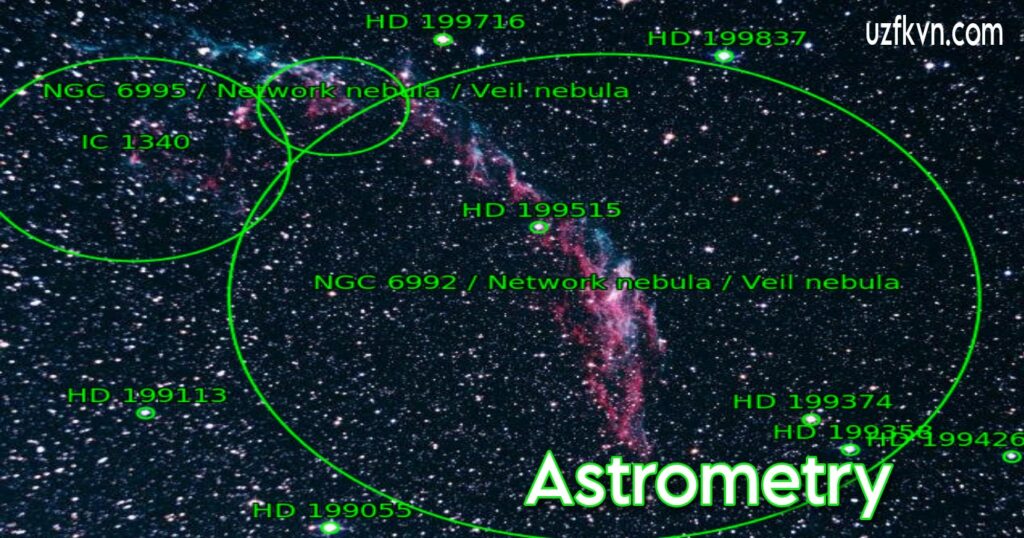Hello friends, I am Uzaif Kevin the author of your own website uzfkvn.com I hope you all are absolutely fine. I’m fine too. So without wasting time, in this Article I will tell you “ What is Astronomy? And how many branches does it have? ”
Soo Lets Begin,
What is Astronomy?
Astronomy is the scientific study of celestial objects and phenomena that originate beyond the Earth’s atmosphere. It encompasses a wide range of topics, including the study of planets, stars, galaxies, and the universe as a whole.
Astronomy involves the use of both observational and theoretical methods to understand the physical and chemical properties of these celestial objects and the processes that govern their behavior and evolution.
Observational astronomy involves the use of telescopes, both on the ground and in space, to study celestial objects in various wavelengths of light, from radio waves to gamma rays.
Theoretical astronomy involves the use of mathematical models and computer simulations to develop and test theories about the behavior of celestial objects.
Astronomy has contributed to many important discoveries and insights, such as the understanding of the motions of the planets, the discovery of black holes and dark matter, and the development of the Big Bang theory of the origin of the universe.
It also plays a critical role in the search for extraterrestrial life and the exploration of our own solar system and beyond.
I hope you guys must have understood Astronomy very well.

How many branches Of Astronomy?
There are twelve branches of Astronomy:
Astronautics, Astrophysics, Astrochemistry, Astrobiology, Cosmology, Astrogeology, Astrometry, Observational Astronomy, Planetary Astronomy, Stellar Astronomy, Galactic Astronomy and Solar Astronomy.

1. Astronautics
Astronautics is a branch of engineering that deals with the design, development, and operation of spacecraft and related technology. It is a multidisciplinary field that encompasses various aspects of engineering, including mechanical, electrical, aerospace, and computer engineering.
Astronautics involves the study of space vehicles, including rockets, satellites, and spacecraft, and their subsystems, such as propulsion, guidance and control, power, and communication. It also involves the study of the space environment and how it affects spacecraft and their missions.
Astronautics is a critical field for space exploration and development. It plays a crucial role in enabling scientific research and discovery, communication, navigation, national security, and commerce in space.
As such, it is an essential part of the global space industry and has significant implications for humanity’s future in space.

2. Astrophysics
Astrophysics is a branch of astronomy that studies the physical properties and behavior of celestial objects and phenomena using the principles of physics.
It involves the application of the laws of physics to understand the nature and behavior of celestial objects, such as stars, planets, galaxies, and the universe as a whole.
Astrophysics seeks to answer fundamental questions about the nature of the universe, such as its origin, evolution, and ultimate fate.
It also aims to understand the physical processes that occur in celestial objects, such as nuclear reactions in stars, gravitational interactions between objects, and the behavior of matter and energy in extreme conditions, such as in black holes and supernovae.
Astrophysics is a highly interdisciplinary field, drawing on principles from physics, mathematics, and astronomy. It is essential for advancing our understanding of the universe and has contributed to numerous technological advancements, such as space exploration, satellite technology, and astronomical instrumentation.

3. Astrochemistry
Astrochemistry is the study of the chemical composition and reactions occurring in the universe. It involves the application of principles of chemistry and physics to study the formation, evolution, and chemical processes of celestial objects, including stars, planets, comets, and interstellar and intergalactic media.
Astrochemistry aims to understand the chemical reactions that occur in space, including the formation of complex organic molecules, the chemical evolution of the universe, and the impact of these reactions on the development of life.
The field also investigates the chemical composition of celestial objects and the distribution of elements in space.
Astrochemistry is a highly interdisciplinary field, involving collaborations between astronomers, physicists, and chemists.
It has important implications for many areas of research, including the origins of the solar system, the search for life in the universe, and the development of new technologies for space exploration.

4. Astrobiology
Astrobiology is the study of the origins, evolution, distribution, and future of life in the universe. It is an interdisciplinary field that draws upon principles and techniques from biology, astronomy, geology, chemistry, and physics.
Astrobiology aims to understand the conditions necessary for the formation and evolution of life in the universe, including the study of potential habitats for life beyond Earth, such as exoplanets and moons.
The field also investigates the limits of life and the search for biosignatures, or signs of life, in other planetary systems.
Astrobiology is a rapidly growing field, and its research has significant implications for the search for extraterrestrial life, the development of new technologies for space exploration, and our understanding of the origins and evolution of life on Earth.
The field also addresses questions related to the habitability of other planets and the potential for future colonization of space by humans.

5. Cosmology
Cosmology is the scientific study of the origin, evolution, and structure of the universe. It is a branch of astronomy that seeks to understand the nature and behavior of the universe as a whole.
Cosmology aims to answer fundamental questions about the universe, such as its age, size, and composition, as well as its ultimate fate.
It also seeks to understand the processes that have shaped the universe, including the Big Bang, the formation of galaxies, and the distribution of matter and energy.
Cosmology involves the use of various methods and techniques, including observational astronomy, theoretical physics, and mathematical modeling. It also involves collaborations between astronomers, physicists, and other scientists.
Cosmology has profound implications for our understanding of the universe and our place in it.
It has led to many important discoveries, such as the discovery of dark matter and dark energy, and has contributed to our understanding of the early universe, the formation of stars and galaxies, and the structure of the universe on the largest scales.

6. Astrogeology
Astrogeology is the study of the geology of celestial bodies, including planets, moons, asteroids, comets, and other solid bodies in our solar system and beyond. It is a subfield of geology that applies principles and techniques of geology to the study of extraterrestrial bodies.
Astrogeology involves the use of various methods and instruments, such as remote sensing, spacecraft observations, and laboratory analysis of planetary samples.
It aims to understand the geological processes that have shaped these bodies, such as impact cratering, volcanism, tectonism, and erosion.
The field also seeks to understand the formation and evolution of these bodies, their composition and structure, and their potential for supporting life.
Astrogeology has significant implications for the exploration and understanding of the solar system and beyond. It plays a crucial role in the selection of landing sites for robotic missions and the interpretation of data from these missions.
It also contributes to our understanding of the geological history of the solar system and the potential for future human exploration and colonization of space.

7. Astrometry
Astrometry is the branch of astronomy that is concerned with the precise measurement of the positions, motions, and distances of celestial objects. It is a fundamental technique used in observational astronomy and is essential for understanding the structure and evolution of the universe.
Astrometry involves the use of specialized instruments, such as telescopes and cameras, to measure the positions and movements of celestial objects with high accuracy.
It also involves the use of mathematical models to interpret these measurements and derive information about the objects being studied, such as their distances, sizes, and motions.
Astrometry plays an important role in a wide range of astronomical studies, from mapping the positions and movements of stars in our galaxy to measuring the positions and motions of distant galaxies.
It is also critical for the detection and characterization of exoplanets, as it allows astronomers to measure the slight wobbles in a star’s position caused by the gravitational pull of orbiting planets.

8. Observational Astronomy
Observational astronomy is a branch of astronomy that is concerned with the direct observation and study of celestial objects using telescopes and other instruments.
It involves the collection and analysis of data from these observations to understand the properties and behavior of celestial objects, including stars, galaxies, planets, and other bodies in the universe.
Observational astronomy encompasses a wide range of techniques and methods, including optical, radio, X-ray, and gamma-ray observations.
It also involves the use of ground-based telescopes, space-based observatories, and other instruments, such as interferometers and spectrographs.
Observational astronomy is essential for testing and developing theories in astrophysics and cosmology. It has led to many important discoveries, such as the discovery of exoplanets, the detection of gravitational waves, and the confirmation of the Big Bang theory.
It also plays a critical role in our understanding of the origins and evolution of the universe and the search for life beyond Earth.
Observational astronomy requires careful planning and execution, as well as expertise in data analysis and interpretation. It is a highly collaborative field that involves astronomers, physicists, engineers, and other scientists from around the world.

9. Planetary Astronomy
Planetary astronomy is a subfield of astronomy that is concerned with the study of planets, moons, asteroids, and other objects in the solar system. It involves the use of observational and theoretical methods to understand the properties, behavior, and evolution of these bodies.
Planetary astronomy involves the study of the surfaces, interiors, atmospheres, and magnetic fields of these objects. It also involves the study of the processes that have shaped and continue to shape these bodies, such as impact cratering, volcanism, tectonics, and erosion.
The field also includes the study of the origins and evolution of the solar system, including the formation of planets and the early history of the solar system.
Planetary astronomy utilizes a wide range of observational techniques, including imaging, spectroscopy, and radar, as well as theoretical models to interpret the data collected from these observations.
It also involves the use of spacecraft missions to explore and study the surfaces and interiors of planets and moons in detail.
Planetary astronomy has led to many important discoveries and insights, such as the detection of water on Mars and other bodies, the discovery of the Kuiper Belt, and the understanding of the geological processes that have shaped the surfaces of planets and moons.
It also plays a critical role in the exploration and understanding of the potential habitability of other bodies in the solar system and beyond.

10. Stellar Astronomy
Stellar astronomy is a subfield of astronomy that is concerned with the study of stars, their properties, behavior, and evolution. It involves the use of observational and theoretical methods to understand the physics of stars and their role in the structure and evolution of galaxies.
Stellar astronomy covers a wide range of topics, including the structure and properties of stars, such as their mass, size, temperature, luminosity, and chemical composition.
It also involves the study of the processes that power stars, such as nuclear fusion and the release of energy through radiation and convection.
The field also includes the study of the various stages of stellar evolution, from the formation of stars to their ultimate fates as white dwarfs, neutron stars, or black holes.
Stellar astronomy utilizes a wide range of observational techniques, including photometry, spectroscopy, and astrometry, as well as theoretical models to interpret the data collected from these observations.
It also involves the use of space-based telescopes and ground-based observatories to study stars in different wavelengths, from X-rays to radio waves.
Stellar astronomy has led to many important discoveries and insights, such as the discovery of the Hertzsprung-Russell diagram, which relates a star’s luminosity and temperature, the detection of exoplanets, and the understanding of the nucleosynthesis of chemical elements in stars.
It also plays a critical role in our understanding of the evolution and structure of galaxies and the search for life beyond Earth.

11. Galactic Astronomy
Galactic astronomy is a subfield of astronomy that is concerned with the study of the Milky Way galaxy and other galaxies. It involves the use of observational and theoretical methods to understand the structure, properties, and evolution of galaxies.
Galactic astronomy covers a wide range of topics, including the structure of galaxies, such as their morphology, size, and mass distribution. It also involves the study of the different components of galaxies, such as stars, gas, dust, and dark matter.
The field also includes the study of the processes that have shaped and continue to shape galaxies, such as star formation, galaxy mergers, and the growth of supermassive black holes at the centers of galaxies.
Galactic astronomy utilizes a wide range of observational techniques, including imaging, spectroscopy, and radio astronomy, as well as theoretical models to interpret the data collected from these observations.
It also involves the use of space-based telescopes and ground-based observatories to study galaxies in different wavelengths, from X-rays to radio waves.
Galactic astronomy has led to many important discoveries and insights, such as the discovery of the existence of dark matter in galaxies, the understanding of the structure and properties of spiral galaxies like the Milky Way, and the discovery of supermassive black holes at the centers of galaxies.
It also plays a critical role in our understanding of the evolution and history of the universe as a whole.

12. Solar Astronomy
Solar astronomy is a subfield of astronomy that is concerned with the study of the Sun, its properties, behavior, and effects on the solar system. It involves the use of observational and theoretical methods to understand the physics of the Sun and its influence on space weather.
Solar astronomy covers a wide range of topics, including the structure and properties of the Sun, such as its magnetic field, temperature, and composition. It also involves the study of the processes that power the Sun, such as nuclear fusion and the release of energy through radiation and convection.
The field also includes the study of the Sun’s influence on the solar system, such as its magnetic field, solar wind, and its impact on Earth’s climate and technological systems.
Solar astronomy utilizes a wide range of observational techniques, including imaging, spectroscopy, and helioseismology, as well as theoretical models to interpret the data collected from these observations.
It also involves the use of space-based telescopes and ground-based observatories to study the Sun in different wavelengths, from X-rays to radio waves.
Solar astronomy has led to many important discoveries and insights, such as the discovery of sunspots and solar flares, the understanding of the Sun’s 11-year sunspot cycle, and the development of space weather forecasting models.
It also plays a critical role in the study of the potential habitability of other planets, as the Sun’s energy is a key factor in determining whether a planet can support life.

Why is it important for us to know about space?
There are many reasons why it is important for us to know about space:
• Understanding our place in the universe: Studying space helps us to understand our place in the universe and how we fit into the larger picture of cosmic evolution.
• Technological advancements: Space exploration has led to many technological advancements in areas such as telecommunications, computing, and materials science, among others.
• Earth observation and monitoring: Many space-based instruments are used to study the Earth’s environment, weather patterns, and natural disasters. This helps us to better understand our planet and to develop strategies for mitigating environmental risks.
• Improving our quality of life: Space-based technologies such as GPS, weather forecasting, and satellite imaging have improved our daily lives in many ways, from navigation to disaster response.
• Advancing scientific knowledge: Space exploration has led to many scientific discoveries and insights, such as the discovery of new planets, the study of the formation of stars and galaxies, and the search for extraterrestrial life.
• Inspiring future generations: Space exploration and the study of space have captured the imagination of people all over the world and have inspired many young people to pursue careers in science, technology, engineering, and math.
Recommended Post
- Gyanvapi Masjid का खुलासा: सामने आया मंदिर-मस्जिद विवाद के पीछे का सच!
- Muharram का पवित्र महीना: आस्था, बलिदान और कर्बला की लड़ाई की अनकही कहानी
- पुलिस ने X पर फर्जी संदेश को लेकर Dhruv Rathee के खिलाफ FIR दर्ज किया
- Bhole Baba Hathras Stampede: मुख्यमंत्री ने तत्काल कार्रवाई और प्रमुख वित्तीय सहायता का आदेश दिया
- Debit Card Se Loan Kaise Le? | ATM Card Se Loan Kaise Le? 2024

